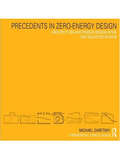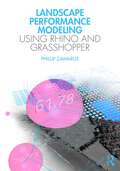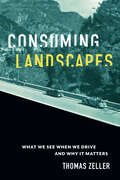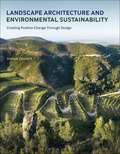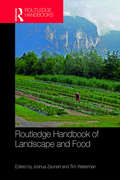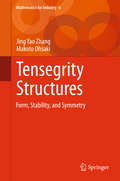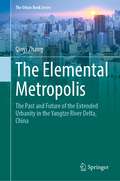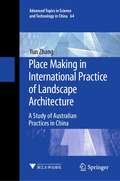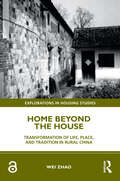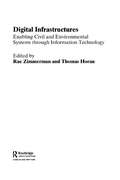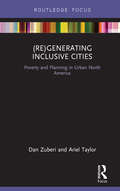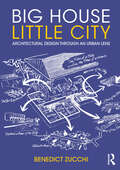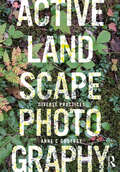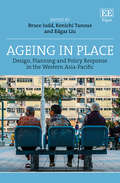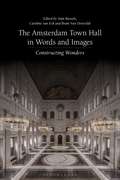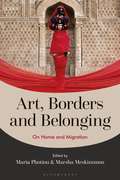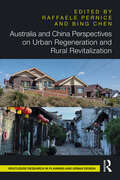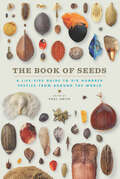- Table View
- List View
Precedents in Zero-Energy Design: Architecture and Passive Design in the 2007 Solar Decathlon
by Michael Zaretsky‘Michael Zaretsky’s Precedents in Zero-Energy Design is such an important book … it will help readers recognize that design comes before technology – and renewable energy systems alone can’t solve the problems we face’ – John D. Quale, Assistant Professor of Architecture and ecoMOD Project Director, University of Virginia The world is currently facing an environmental crisis and as anyone interested in sustainable or zero-energy design knows the design and building industries have the potential to significantly reduce greenhouse gas emissions across the globe. The Solar Decathlon is an international event in which universities from around the world compete in the design and construction of a one-bedroom, zero-energy house. This book provides an in-depth, yet accessible analysis of the architecture and passive design strategies of the houses in the 2007 Solar Decathlon. These houses are the result of thousands of hours of research and development from twenty universities around the world. Divided into three parts, the book provides: an initial section investigating the architecture, passive design and systems layout of the twenty houses; a diagrammatic comparison of the architecture and passive design characteristics of each of the twenty houses in order of ranking by the Architecture, Comfort Zone and overall scores received in the competition; a deep analysis of the relationship between architecture, passive design and mechanical systems design as compared to the rankings received in the various contests. This analysis considers the decisions made by the competing teams and highlights the success of the design strategies employed. Students, educators, practitioners and researchers of architecture, design and engineering will find this an informative and inspirational book. It examines the relationship between design and environmental principles and provides invaluable insight into some of the most innovative, off-the-grid and zero-energy houses in the world. With a Foreword by John D. Quale, Assistant Professor of Architecture and ecoMOD Project Director, University of Virginia
Precedents in Zero-Energy Design: Architecture and Passive Design in the 2007 Solar Decathlon
by Michael Zaretsky‘Michael Zaretsky’s Precedents in Zero-Energy Design is such an important book … it will help readers recognize that design comes before technology – and renewable energy systems alone can’t solve the problems we face’ – John D. Quale, Assistant Professor of Architecture and ecoMOD Project Director, University of Virginia The world is currently facing an environmental crisis and as anyone interested in sustainable or zero-energy design knows the design and building industries have the potential to significantly reduce greenhouse gas emissions across the globe. The Solar Decathlon is an international event in which universities from around the world compete in the design and construction of a one-bedroom, zero-energy house. This book provides an in-depth, yet accessible analysis of the architecture and passive design strategies of the houses in the 2007 Solar Decathlon. These houses are the result of thousands of hours of research and development from twenty universities around the world. Divided into three parts, the book provides: an initial section investigating the architecture, passive design and systems layout of the twenty houses; a diagrammatic comparison of the architecture and passive design characteristics of each of the twenty houses in order of ranking by the Architecture, Comfort Zone and overall scores received in the competition; a deep analysis of the relationship between architecture, passive design and mechanical systems design as compared to the rankings received in the various contests. This analysis considers the decisions made by the competing teams and highlights the success of the design strategies employed. Students, educators, practitioners and researchers of architecture, design and engineering will find this an informative and inspirational book. It examines the relationship between design and environmental principles and provides invaluable insight into some of the most innovative, off-the-grid and zero-energy houses in the world. With a Foreword by John D. Quale, Assistant Professor of Architecture and ecoMOD Project Director, University of Virginia
Landscape Performance Modeling Using Rhino and Grasshopper
by Phillip ZawarusThis is a guidebook for landscape architects to learn the fundamental practices and use of the computational software Rhino 3D and the plugin Grasshopper for parametric modeling, landscape inventory, and performative analysis. This process visually connects intangible and abstract information with physical and spatial relationships to signify the impact ecological, climate, and cultural factors have on landscape performance and decision making. Each chapter begins with a summary of the performance method and its application in different projects, outlining the expected goals from industry standard equations and operations. Chapters cover parametric modeling scripts to measure ecosystem services of stormwater management, erosion control, tree benefits, outdoor comfort, accessibility, and many others. Using photographs, tables, and parametric scripts to create qualitative and quantitative representations of landscape performance and ecosystem services, readers will learn to communicate the impact and significance of their outputs. This book will be beneficial to educators, students, and professionals interested in using computational modeling as a performance assessment and graphic visualization tool.
Landscape Performance Modeling Using Rhino and Grasshopper
by Phillip ZawarusThis is a guidebook for landscape architects to learn the fundamental practices and use of the computational software Rhino 3D and the plugin Grasshopper for parametric modeling, landscape inventory, and performative analysis. This process visually connects intangible and abstract information with physical and spatial relationships to signify the impact ecological, climate, and cultural factors have on landscape performance and decision making. Each chapter begins with a summary of the performance method and its application in different projects, outlining the expected goals from industry standard equations and operations. Chapters cover parametric modeling scripts to measure ecosystem services of stormwater management, erosion control, tree benefits, outdoor comfort, accessibility, and many others. Using photographs, tables, and parametric scripts to create qualitative and quantitative representations of landscape performance and ecosystem services, readers will learn to communicate the impact and significance of their outputs. This book will be beneficial to educators, students, and professionals interested in using computational modeling as a performance assessment and graphic visualization tool.
Consuming Landscapes: What We See When We Drive and Why It Matters
by Thomas ZellerWhat we see through our windshields reflects ideas about our national identity, consumerism, and infrastructure.For better or worse, windshields have become a major frame for viewing the nonhuman world. The view from the road is one of the main ways in which we experience our environments. These vistas are the result of deliberate historical forces, and humans have shaped them as they simultaneously sought to be transformed by them. In Consuming Landscapes, Thomas Zeller explores how what we see while driving reflects how we view our societies and ourselves, the role that consumerism plays in our infrastructure, and ideas about reshaping the environment in the twentieth century.Zeller breaks new ground by comparing the driving experience and the history of landscaped roads in the United States and Germany, two major automotive countries. He focuses specifically on the Blue Ridge Parkway in the United States and the German Alpine Road as case studies. When the automobile was still young, an early twentieth-century group of designers—landscape architects, civil engineers, and planners—sought to build scenic infrastructures, or roads that would immerse drivers in the landscapes that they were traversing. As more Americans and Europeans owned cars and drove them, however, they became less interested in enchanted views; safety became more important than beauty. Clashes between designers and drivers resulted in different visions of landscapes made for automobiles. As strange as it may seem to twenty-first-century readers, many professionals in the early twentieth century envisioned cars and roads, if properly managed, as saviors of the environment. Consuming Landscapes illustrates how the meaning of infrastructures changed as a result of use and consumption. Such changes indicate a deep ambivalence toward the automobile and roads, prompting the question: can cars and roads bring us closer to nature while deeply altering it at the same time?
Consuming Landscapes: What We See When We Drive and Why It Matters
by Thomas ZellerWhat we see through our windshields reflects ideas about our national identity, consumerism, and infrastructure.For better or worse, windshields have become a major frame for viewing the nonhuman world. The view from the road is one of the main ways in which we experience our environments. These vistas are the result of deliberate historical forces, and humans have shaped them as they simultaneously sought to be transformed by them. In Consuming Landscapes, Thomas Zeller explores how what we see while driving reflects how we view our societies and ourselves, the role that consumerism plays in our infrastructure, and ideas about reshaping the environment in the twentieth century.Zeller breaks new ground by comparing the driving experience and the history of landscaped roads in the United States and Germany, two major automotive countries. He focuses specifically on the Blue Ridge Parkway in the United States and the German Alpine Road as case studies. When the automobile was still young, an early twentieth-century group of designers—landscape architects, civil engineers, and planners—sought to build scenic infrastructures, or roads that would immerse drivers in the landscapes that they were traversing. As more Americans and Europeans owned cars and drove them, however, they became less interested in enchanted views; safety became more important than beauty. Clashes between designers and drivers resulted in different visions of landscapes made for automobiles. As strange as it may seem to twenty-first-century readers, many professionals in the early twentieth century envisioned cars and roads, if properly managed, as saviors of the environment. Consuming Landscapes illustrates how the meaning of infrastructures changed as a result of use and consumption. Such changes indicate a deep ambivalence toward the automobile and roads, prompting the question: can cars and roads bring us closer to nature while deeply altering it at the same time?
Landscape Architecture and Environmental Sustainability: Creating Positive Change Through Design (Required Reading Range)
by Joshua ZeunertWinner of the Australian Institute of Landscape Architects (AILA) National Excellence Award (Research and Communication) 2017Winner of the AILA VIC Excellence Award (Research and Communication) 2017Highly Commended (Communication and Presentation) Landscape Institute Awards 2018Landscape architecture has a pivotal role in ensuring environmental sustainability through design interventions. This book takes a broad look at strategies and completed projects to provide the reader with a strong understanding of the sustainability challenges being faced by designers today, and potential routes to addressing them. The book covers essential concepts of landscape architecture and environmental sustainability, including: - Ecology, multifunctional landscapes and sensitive intervention- Remediation, cleansing and environmental infrastructure- Social sustainability, design activism and healthy landscapes - Food systems, productive landscapes and transportation- Performance ratings, materials and life cycles Through case studies from around the world and interviews with leading landscape architects and practitioners, this book invites discussion about possible future scenarios, relevant theories and project responses in landscape environmental design. With hundreds of color images throughout the book, and additional study material in the companion website, Joshua Zeunert provides an overview of the multidimensional qualities of landscape sustainability.
Routledge Handbook of Landscape and Food
by Joshua Zeunert Tim WatermanSince the turn of the millennium, there has been a burgeoning interest in, and literature of, both landscape studies and food studies. Landscape describes places as relationships and processes. Landscapes create people’s identities and guide their actions and their preferences, while at the same time are shaped by the actions and forces of people. Food, as currency, medium, and sustenance, is a fundamental part of those landscape relationships. This volume brings together over fifty contributors from around the world in forty profoundly interdisciplinary chapters. Chapter authors represent an astonishing range of disciplines, from agronomy, anthropology, archaeology, conservation, countryside management, cultural studies, ecology, ethics, geography, heritage studies, landscape architecture, landscape management and planning, literature, urban design and architecture. Both food studies and landscape studies defy comprehension from the perspective of a single discipline, and thus such a range is both necessary and enriching. The Routledge Handbook of Landscape and Food is intended as a first port of call for scholars and researchers seeking to undertake new work at the many intersections of landscape and food. Each chapter provides an authoritative overview, a broad range of pertinent readings and references, and seeks to identify areas where new research is needed—though these may also be identified in the many fertile areas in which subjects and chapters overlap within the book.
Routledge Handbook of Landscape and Food
by Joshua Zeunert Tim WatermanSince the turn of the millennium, there has been a burgeoning interest in, and literature of, both landscape studies and food studies. Landscape describes places as relationships and processes. Landscapes create people’s identities and guide their actions and their preferences, while at the same time are shaped by the actions and forces of people. Food, as currency, medium, and sustenance, is a fundamental part of those landscape relationships. This volume brings together over fifty contributors from around the world in forty profoundly interdisciplinary chapters. Chapter authors represent an astonishing range of disciplines, from agronomy, anthropology, archaeology, conservation, countryside management, cultural studies, ecology, ethics, geography, heritage studies, landscape architecture, landscape management and planning, literature, urban design and architecture. Both food studies and landscape studies defy comprehension from the perspective of a single discipline, and thus such a range is both necessary and enriching. The Routledge Handbook of Landscape and Food is intended as a first port of call for scholars and researchers seeking to undertake new work at the many intersections of landscape and food. Each chapter provides an authoritative overview, a broad range of pertinent readings and references, and seeks to identify areas where new research is needed—though these may also be identified in the many fertile areas in which subjects and chapters overlap within the book.
Tensegrity Structures: Form, Stability, and Symmetry (Mathematics for Industry #6)
by Jing Yao Zhang Makoto OhsakiTo facilitate a deeper understanding of tensegrity structures, this book focuses on their two key design problems: self-equilibrium analysis and stability investigation. In particular, high symmetry properties of the structures are extensively utilized. Conditions for self-equilibrium as well as super-stability of tensegrity structures are presented in detail. An analytical method and an efficient numerical method are given for self-equilibrium analysis of tensegrity structures: the analytical method deals with symmetric structures and the numerical method guarantees super-stability. Utilizing group representation theory, the text further provides analytical super-stability conditions for the structures that are of dihedral as well as tetrahedral symmetry. This book not only serves as a reference for engineers and scientists but is also a useful source for upper-level undergraduate and graduate students. Keeping this objective in mind, the presentation of the book is self-contained and detailed, with an abundance of figures and examples.
The Elemental Metropolis: The Past and Future of the Extended Urbanity in the Yangtze River Delta, China (The Urban Book Series)
by Qinyi ZhangThis book provides a multi-scale reading of the spatial “elements” in which the extensive urbanity in Yangtze River Delta is constructed, and from there an imagination of a new paradigm of urbanization. The urbanization in Yangtze River Delta today is in need of a new interpretation and paradigm. The delta is a territory with city cores but it also has vast dispersed urbanization where the agricultural and non-agricultural activities and spaces are mixed and interlinked, a desakota (McGee, 1991). This book attempts to answer a basic question: what is the desakota in the Yangtze River Delta made of? The research Horizontal Metropolis led by Prof. Paola Viganò at EPFL, Switzerland focuses on the form of the contemporary city – the fragmentary spatial condition and dispersed urbanity all over the world. The study on Yangtze River delta is part of its research frame.
Place Making in International Practice of Landscape Architecture: A Study of Australian Practices in China (Advanced Topics in Science and Technology in China #64)
by Yun ZhangThis book explores international practice in landscape architecture, focusing on the provision of services from Australia to China during China’s contemporary urbanization and Australian landscape architects’ approaches to place. Landscape architectural practice requires planners and designers to have a deep understanding of local culture, site characteristics, craftsmanship and even project procedures that are often intangible. How to acquire the above local knowledge has become a major challenge for international teams. Through the survey of the practice of Australian landscape practices in China and the case study of Li Lake planning and design project, this book reveals the process and difficulties of landscape planning and design as a transnational practice, as well as its special value as a way of cross-cultural fertilization. This book is intended for students, practitioners and researchers in the fields of landscape architecture, architecture and urban planning.
Home Beyond the House: Transformation of Life, Place, and Tradition in Rural China (Explorations in Housing Studies)
by Wei ZhaoBased on extended fieldwork conducted between 2007 and 2019, this book aims to answer a simple question: What is the meaning of home for people living in vernacular settlements in rural China? This question is particularly potent since rural China has experienced rapid and fundamental changes in the twenty-first century under the influences of national policies such as "Building a New Socialist Countryside" enacted in 2006 and "Rural Revitalization" announced in 2018. Drawing upon ethnographic fieldwork, building surveys, archival research, and over 600 photographs taken by residents along with their life stories, this book uncovers the meanings of home from rural residents’ perspectives, who belong to a social group that is underrepresented in scholarship and underserved in modern China. In other words, this study empowers rural residents by giving them voice. This book links the concepts of place, home, and tradition into an overarching argument: The meaning of home rests on the ideas of tradition, including identity, consanguinity, collectivity, social relations, land ownership, and rural lifestyle.
Home Beyond the House: Transformation of Life, Place, and Tradition in Rural China (Explorations in Housing Studies)
by Wei ZhaoBased on extended fieldwork conducted between 2007 and 2019, this book aims to answer a simple question: What is the meaning of home for people living in vernacular settlements in rural China? This question is particularly potent since rural China has experienced rapid and fundamental changes in the twenty-first century under the influences of national policies such as "Building a New Socialist Countryside" enacted in 2006 and "Rural Revitalization" announced in 2018. Drawing upon ethnographic fieldwork, building surveys, archival research, and over 600 photographs taken by residents along with their life stories, this book uncovers the meanings of home from rural residents’ perspectives, who belong to a social group that is underrepresented in scholarship and underserved in modern China. In other words, this study empowers rural residents by giving them voice. This book links the concepts of place, home, and tradition into an overarching argument: The meaning of home rests on the ideas of tradition, including identity, consanguinity, collectivity, social relations, land ownership, and rural lifestyle.
Digital Infrastructures: Enabling Civil and Environmental Systems through Information Technology (Networked Cities Series)
by Rae Zimmerman Thomas HoranAn invisible network of digital technology systems underlies the highly visible networks of roads, waterways, satellites, and power-lines. Increasingly, these systems are becoming the "infrastructure's infrastructure," providing a crucial array of data on network demand, performance, reliability, and security. Digital Infrastructures presents an interdisciplinary analysis of the technological systems that envelop these networks. The book balances analyses of specific civil and environmental infrastructures with broader policy and management issues, including the challenges of using IT to manage these critical systems under crises conditions.
(Re)Generating Inclusive Cities: Poverty and Planning in Urban North America
by Dan Zuberi Ariel Judith TaylorAs suburban expansion declines, cities have become essential economic, cultural and social hubs of global connectivity. This book is about urban revitalization across North America, in cities including San Francisco, Toronto, Boston, Vancouver, New York and Seattle. Infrastructure projects including the High Line and Big Dig are explored alongside urban neighborhood creation and regeneration projects such as Hunters Point in San Francisco and Regent Park in Toronto. Today, these urban regeneration projects have evolved in the context of unprecedented neoliberal public policy and soaring real estate prices. Consequently, they make a complex contribution to urban inequality and poverty trends in many of these cities, including the suburbanization of immigrant settlement and rising inequality. (Re)Generating Inclusive Cities wrestles with challenging but important questions of urban planning, including who benefits and who loses with these urban regeneration schemes, and what policy tools can be used to mitigate harm? We propose a new way forward for understanding and promoting better urban design practices in order to build more socially just and inclusive cities and to ultimately improve the quality of urban life for all.
(Re)Generating Inclusive Cities: Poverty and Planning in Urban North America
by Dan Zuberi Ariel Judith TaylorAs suburban expansion declines, cities have become essential economic, cultural and social hubs of global connectivity. This book is about urban revitalization across North America, in cities including San Francisco, Toronto, Boston, Vancouver, New York and Seattle. Infrastructure projects including the High Line and Big Dig are explored alongside urban neighborhood creation and regeneration projects such as Hunters Point in San Francisco and Regent Park in Toronto. Today, these urban regeneration projects have evolved in the context of unprecedented neoliberal public policy and soaring real estate prices. Consequently, they make a complex contribution to urban inequality and poverty trends in many of these cities, including the suburbanization of immigrant settlement and rising inequality. (Re)Generating Inclusive Cities wrestles with challenging but important questions of urban planning, including who benefits and who loses with these urban regeneration schemes, and what policy tools can be used to mitigate harm? We propose a new way forward for understanding and promoting better urban design practices in order to build more socially just and inclusive cities and to ultimately improve the quality of urban life for all.
Big House Little City: Architectural Design Through an Urban Lens
by Benedict ZucchiCombining architectural and urban thinking in an unusual and engaging way, this book presents an integrated approach to architectural theory and design. Leon Battista Alberti’s assertion in his famous Renaissance treatise that ‘the city is like a big house, and the house is in turn like a little city’ forms the springboard for a series of reflections on architecture’s relationship with urbanism and how their once intimate symbiosis, unravelled by International Style Modernism, can be recovered. Explicit references to Alberti’s house-city phrase have been made by figures as diverse as the architects Louis Kahn, Aldo Van Eyck, Denys Lasdun and Niels Torp and novelist Italo Calvino. But, as the book shows, thinking of buildings as little cities provides a new lens through which to reappraise the contributions of many other architects, including Le Corbusier, Frank Lloyd Wright, Alvar Aalto, Eliel Saarinen, Bernard Rudofsky, Hans Scharoun, Leon Krier, Fumihiko Maki, Charles Correa and Team 10. In doing so, the author identifies common themes that form an unexpected bridgehead between the urban and architectural approaches of Antiquity, the Middle Ages, Renaissance and 20th century. The book explores buildings from across the globe, including lesser-known projects, such as Wright’s unbuilt house in Italy or Saarinen’s master plan for Cranbrook Academy, as well as more recent projects by Niels Torp, Behnisch Architekten, Sou Fujimoto, Peter Barber and WOHA. It concludes with practical case studies of residential, health, education and workplace projects from different countries, fulsomely illustrated with many drawings and photographs. These show how architectural design viewed through an urban lens provides a conceptual framework for breaking down the scale of large buildings and integrating them with their context. And crucially, these also show a very accessible way of explaining evolving designs to the intended users and eliciting their participation in the design process. The book offers a compelling approach to the design of projects at all scales, within an ecological perspective: the sense that big and small, cities and buildings must be approached holistically if we are to reverse the degradation and depletion of our habitat, both natural and man-made.
Big House Little City: Architectural Design Through an Urban Lens
by Benedict ZucchiCombining architectural and urban thinking in an unusual and engaging way, this book presents an integrated approach to architectural theory and design. Leon Battista Alberti’s assertion in his famous Renaissance treatise that ‘the city is like a big house, and the house is in turn like a little city’ forms the springboard for a series of reflections on architecture’s relationship with urbanism and how their once intimate symbiosis, unravelled by International Style Modernism, can be recovered. Explicit references to Alberti’s house-city phrase have been made by figures as diverse as the architects Louis Kahn, Aldo Van Eyck, Denys Lasdun and Niels Torp and novelist Italo Calvino. But, as the book shows, thinking of buildings as little cities provides a new lens through which to reappraise the contributions of many other architects, including Le Corbusier, Frank Lloyd Wright, Alvar Aalto, Eliel Saarinen, Bernard Rudofsky, Hans Scharoun, Leon Krier, Fumihiko Maki, Charles Correa and Team 10. In doing so, the author identifies common themes that form an unexpected bridgehead between the urban and architectural approaches of Antiquity, the Middle Ages, Renaissance and 20th century. The book explores buildings from across the globe, including lesser-known projects, such as Wright’s unbuilt house in Italy or Saarinen’s master plan for Cranbrook Academy, as well as more recent projects by Niels Torp, Behnisch Architekten, Sou Fujimoto, Peter Barber and WOHA. It concludes with practical case studies of residential, health, education and workplace projects from different countries, fulsomely illustrated with many drawings and photographs. These show how architectural design viewed through an urban lens provides a conceptual framework for breaking down the scale of large buildings and integrating them with their context. And crucially, these also show a very accessible way of explaining evolving designs to the intended users and eliciting their participation in the design process. The book offers a compelling approach to the design of projects at all scales, within an ecological perspective: the sense that big and small, cities and buildings must be approached holistically if we are to reverse the degradation and depletion of our habitat, both natural and man-made.
Active Landscape Photography: Diverse Practices (Active Landscape Photography)
Diverse Practices, the third book in the Active Landscape Photography series, presents a set of unique photographic examples for site-specific investigations of landscape places. Contributed by authors across academia, practice and photography, each chapter serves as a rigorous discussion about photographic methods for the landscape and their underlying concepts. Chapters also serve as unique case studies about specific projects, places and landscape issues. Project sites include the Miller Garden, Olana, XX Miller Prize and the Philando Castile Peace Garden. Landscape places discussed include the archeological landscapes of North Peru, watery littoral zones, the remote White Pass in Alaska, Sau Paulo and New York City’s Chinatown. Photographic image-making approaches include the use of lidar, repeat photography, collage, mapping, remote image capture, portraiture, image mining of internet sources, visual impact assessment, cameraless photography, transect walking and interviewing. These diverse practices demonstrate how photography, when utilized through a set of specific critical methods, becomes a rich process for investigating the landscape. Exploring this concept in relationship to specific contemporary sties and landscape issues reveals the intricacy and subtlety that exists when photography is used actively. Practitioners, academics, students and researchers will be inspired by the underlying concepts of these examples and come away with a better understanding about how to create their own rigorous photographic practices.
Ageing in Place: Design, Planning and Policy Response in the Western Asia-Pacific
Encouraging older people to age in place in their own homes is a common response internationally to the economic and social demands of population ageing. It is recognized that the nature of the built environment at various scales is critical to optimizing the social participation and wellbeing of older people and hence in facilitating ageing in place. This insightful book showcases a range of design, planning and policy responses to ageing populations from across the rapidly changing and dynamic Western Asia-Pacific region. Ageing in Place considers diverse cultural, political and environmental contexts and responses to show that regional governments, industries and communities can gain, as well as offer, important insights from their international counterparts. With significant changes in caring, family dynamics and the supporting roles of governments in both Eastern and Western societies, the chapters demonstrate a clear and increasingly convergent preference for and promotion of ageing in place and the need for collaborative efforts to facilitate this through policy and practice. The unique geographical focus and multi-disciplinary perspective of this book will greatly benefit academic researchers and students from a variety of backgrounds including architecture, urban planning, sociology and human geography. It also provides a unique entry point for practitioners seeking to understand the principles of design and practice for ageing in place in homes, neighbourhoods and care facilities.
The Amsterdam Town Hall in Words and Images: Constructing Wonders
The most famous monument of the Dutch Golden Age is undoubtedly the Amsterdam Town Hall by architect Jacob van Campen inaugurated in 1655. Today we stand in awe confronted with the grand Classicist façade, the delightful horror of the sculptures in the Tribunal, and the magnificence of the huge Citizens' Hall. In the period of its construction, many artists and writers tried to capture the overwhelming impact of the building by, among other comparisons, relating it to the ancient Wonders of the World and by stressing its splendour, riches, and impressive scale. In doing so, they constructed the Town Hall as the ultimate wonder, thus offering a silent, but very powerful testimony to the power and position of the City of Amsterdam and its rulers as equals of the other European regimes.To fully understand these mechanisms of power, this book relates the Town Hall to other, impressive buildings of the same period-the palace of the Louvre, Saint Peter's Basilica, and Banqueting House-and their visual and textual representations. Thus, this book gives a broad audience of readers new insights into the agency of magnificent buildings. The Amsterdam Town Hall in Words and Images does not restrict itself to a national scope or a purely architectural analysis, but clarifies how artists and writers all over Europe presented buildings as wonders of the world. This book is pioneering in its analysis of seventeenth and eighteenth-century paintings, prints, drawings, poems, and travel accounts and offers a new understanding of how the wondrous character of these grand buildings was constructed.
Art, Borders and Belonging: On Home and Migration
Art, Borders and Belonging: On Home and Migration investigates how three associated concepts-house, home and homeland-are represented in contemporary global art. The volume brings together essays which explore the conditions of global migration as a process that is always both about departures and homecomings, indeed, home-makings, through which the construction of migratory narratives are made possible. Although centrally concerned with how recent and contemporary works of art can materialize the migratory experience of movement and (re)settlement, the contributions to this book also explore how curating and exhibition practices, at both local and global levels, can extend and challenge conventional narratives of art, borders and belonging. A growing number of artists migrate; some for better job opportunities and for the experience of different cultures, others not by choice but as a consequence of forced displacement caused economic or environmental collapse, or by political, religious or military destabilization. In recent years, the theme of migration has emerged as a dominant subject in art and curatorial practices. Art, Borders and Belonging thus seeks to explore how the migratory experience is generated and displayed through the lens of contemporary art. In considering the extent to which the visual arts are intertwined with real life events, this text acts as a vehicle of knowledge transfer of cultural perspectives and enhances the importance of understanding artistic interventions in relation to home, migration and belonging.
Australia and China Perspectives on Urban Regeneration and Rural Revitalization (Routledge Research in Planning and Urban Design)
This edited volume reviews important contemporary issues through relevant case studies and research in China and Australia, such as the challenges posed by climate change, the development of eco-urban design, research on sustainable habitats and the relationship between ecology, green architecture and city regeneration, as well as, in general, the future of the city in the new millennium.The authors represent a broad selection of international experts, young scholars and established academics who discuss themes related to urban–rural destruction and economic and spatial regeneration techniques, the sustainable reconversion of natural landscapes and eco-urban design in the context of the current evolution of architectural and urbanism practice. The book aims to explain the conditions in which the contemporary debate about urban regeneration and rural revitalisation has developed in Australia and China, presented by different theoretical and methodological perspectives. It also provides a multifaceted and critical analysis of relevant case studies and urban experiences in Australia and China, focusing on environmental disruption, resized urban interventions and the need for more efficient and sustainable forms of regeneration and urban renewal practice in urban–rural contexts.This book will be an invaluable resource for architects, planners, architectural and urban historians, geographers, and scholars interested in modern Australian and Chinese architecture and urbanism.
The Book of Seeds: A Life-Size Guide to Six Hundred Species from around the World
Seeds are nature’s consummate survivors. The next time you admire a field of waving green grassland or a stunning grove of acacia, stop to consider how it got that way—often against incredible odds. Seeds can survive freezing temperatures and drought. They can pass through our digestive systems without damage and weather a trip across the ocean, hitching a ride on marine debris. They can even endure complete desiccation, a feat taken to extraordinary lengths by the date palm, a seed from which was recovered from the palace of Herod the Great was germinated after some two thousand years. The Book of Seeds takes readers through six hundred of the world’s seed species, revealing their extraordinary beauty and rich diversity. Each page pairs a beautifully composed photo of a seed—life-size, and, in some cases, enlarged to display fine detail—with a short description, a map showing distribution, and information on conservation status. The whole spectrum of seeds is covered here. There are prolific species like corn and less widely distributed species, like the brilliant blue seeds of the traveler’s palm or the bird of paradise flower, aptly named for its distinctive orange coiffure. There are tiny seeds and seeds weighing up to forty pounds. And while seeds in all their shapes, sizes, and colors grant us sustenance, there are even some we would be wise to treat with caution, such as the rosary pea, whose seeds are considered more toxic than ricin. The essential guide to these complex plant creations, The Book of Seeds offers readers a rare, up-close look that will inspire scientists and nature lovers alike.
